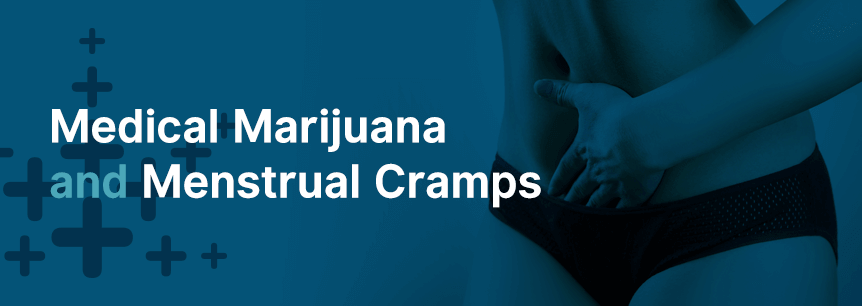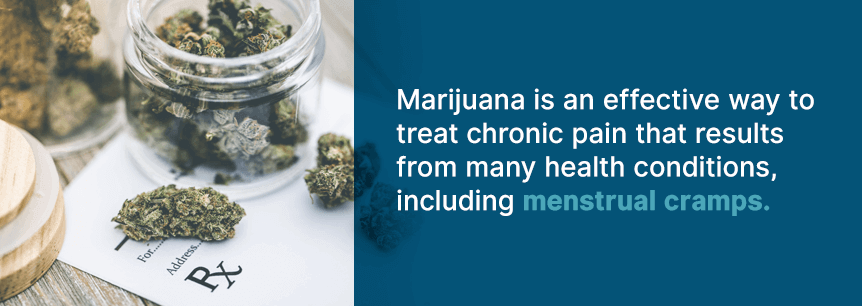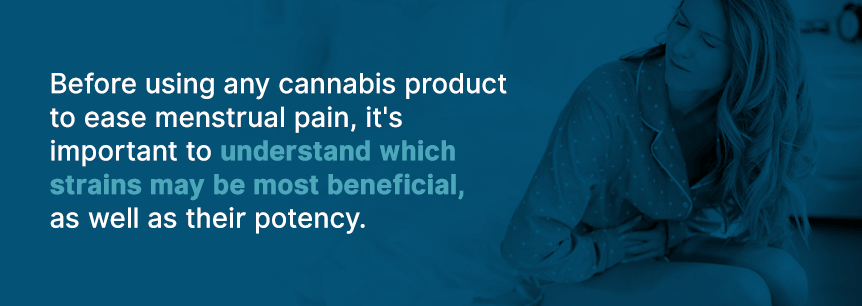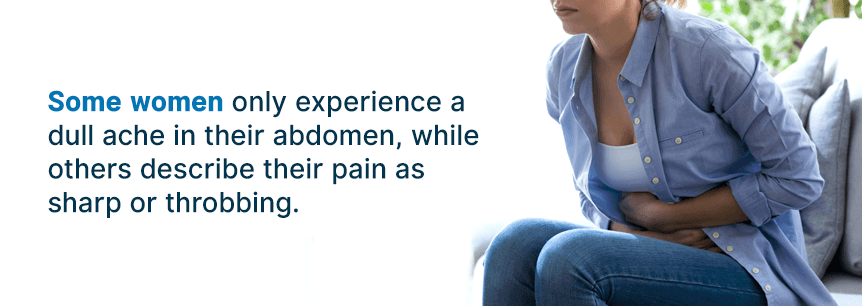
While most women experience menstrual cramps at some point in their life, there is a small group of women for whom menstrual pain becomes debilitating. For these women, what is typically considered to be a minor inconvenience is actually a deeply painful monthly experience that interrupts their daily routine. Women with severe menstrual cramps have been forced to miss work, school and a variety of other essential activities because their pain is too intense to leave the house. Managing their pain has become much more involved than popping ibuprofen for a day or two each month — it has become a struggle to function on a day-to-day basis for several days out of each month.
There is a big difference between someone who smokes a little pot to blow off steam on the weekends and someone who uses marijuana products to control a medical condition. This difference is sometimes overlooked, which is why the idea of using cannabis for medical purposes is surrounded by a lot of negative — and incorrect — information. The truth is that marijuana is an effective way to treat chronic pain that results from many health conditions, including menstrual cramps.

How does smoking pot help the pain? Marijuana contains nearly 80 cannabinoids which stimulate, or activate, the human body’s endocannabinoid receptors. These receptors are in many parts of the body, including the brain. They work by attaching themselves to the cannabinoids’ chemicals and the result, researchers are finding, is a significant reduction in inflammation and pain, as well as a calming impact on the body’s central nervous system.
Although the Food and Drug Administration (FDA) has not approved medical marijuana for pain relief in most cases, there is still an increasing body of research pointing to its effectiveness in treating pain for a variety of chronic conditions, including menstrual pain. As more and more states change their laws to approve the expansion of what conditions can be treated with medical marijuana, the possibility for relief looms large.
One of the reasons that cannabis is gaining traction as a popular alternative to traditional painkillers is because it provides as much or more relief without the side effects or risks of addiction. Besides its low risk of addiction, some users also claim that it is a better painkiller than opioids. In a study of 3,000 medical marijuana users, 87 percent of those users found greater benefits to marijuana compared with opioids they had also used in the six months before the study. While a woman probably isn’t using opioid painkillers to treat menstrual pain, this study is significant because it points to the possibility of marijuana providing a means of pain relief beyond what is currently available.
Marijuana may actually be a safer option for treating menstrual pain than traditional medications because:
Marijuana has a reputation as a pain reliever for a reason — it works. It eases the pain associated with menstrual cramps and helps the individual taking it to relax. Since stress can increase the severity of cramps, helping a woman relax can also go a long way in easing the pain and discomfort cramps cause. Marijuana is also known to treat depression and anxiety, two other symptoms that may accompany PMS. There is evidence that medical use of cannabis over one year results in a marked improvement in function, pain and overall quality of life.
Marijuana comes in many strains that each have slightly different effects. Before using any cannabis product to ease menstrual pain, it’s important to understand which strains may be most beneficial, as well as their potency.


When used to treat menstrual pain, marijuana can be very effective, however, its level of effectiveness is directly related to the quality and sourcing of the product. However, even though the effectiveness depends on the quality, but some people prefer certain delivery methods over others, finding them to deliver a quicker or more intense feeling of relief from pain.
While there are a wide variety of ways a person can get the benefits of marijuana, smoking continues to be one of the most common options. When a person smokes cannabis, it takes effect quickly, easing their pain in a matter of minutes. However, the act of smoking can irritate the lungs, which makes it an uncomfortable option for some people.
When selecting the cannabis or CBD-infused product that is best for an individual, it is important to keep the product’s chemical makeup, as well as the individual’s personal history, in mind. Also, remember CBD-infused products are not straight weed. CBD is a chemical extracted from cannabis, but products infused with CBD will not result in a “high.” In fact, CBD-infused products are becoming increasingly popular for their anti-inflammatory properties and can now be found in a variety of forms, including lotions, beverages, oils and more. Some people are even using it to manage their pets’ health conditions.
Tinctures are also a popular option because they can simply be administered by adding a drop or two to a morning smoothie or even just straight onto a person’s tongue. A tincture is created by infusing high-proof alcohol with cannabinoids and then straining out the leaf remnants. What remains is a potent liquid that allows a person to get the benefits of cannabis without the unwanted side effects that the common smoking method produces.
Another method that’s gaining traction for cannabis users looking to relieve menstrual pain is the suppository. Also commonly known as “weed tampons,” they are inserted into the vagina, and the combination of CBD and THC have been found to ease painful cramping. While pain relief is always a positive thing, many medical professionals question the effectiveness of this method, so it should be considered cautiously until more research can be done.
Similar to tinctures, edibles can be an option as well. Although it takes longer for the effects of the cannabis to kick in, they also last much longer. If a patient doesn’t want to smoke, eating some gummies or chocolate with CBD in it may be a viable option.
While the benefits of using medical marijuana for menstrual cramps are many, studies have found some potential risks and side effects that users should be aware of. The side effects will vary depending on the type and amount of product used, however, it is possible to experience:
Not included in this list is the possibility of developing an addiction to marijuana. Although most people do not become addicted to cannabis — which is one of the reasons some people prefer it over opioids — nine percent of people who begin using pot as adults may become addicted to it. Research also shows that individuals who use marijuana as adolescents and teens are more likely to become addicted than adults.
Some people who use marijuana regularly may develop a dependence on it. This is different than addiction because the individual is still able to stop using pot, whereas an addict cannot control their urge to use marijuana. Someone who has become dependent on marijuana may experience withdrawal symptoms, including irritability, lack of appetite, restlessness or lack of sleep, but these subside after a week or two of not using it.
Activists are pushing for menstrual pain to be included on the list of medical conditions that permit medical marijuana to be used, but there is still a long way to go in normalizing this method of treatment for the pain and discomfort associated with PMS and menstrual cramps. However, the increasing body of evidence for the effectiveness of cannabis in treating menstrual pain cannot be ignored.
Because of the current laws, as well as the growing and changing body of research, it is important to consult with a medical marijuana doctor in your state to determine how cannabis and cannabis-infused products can help improve your quality of life. Whether you’re new to the idea of using pot or you’ve only ever used it recreationally before, don’t be afraid to speak up and ask questions. By selecting a qualified marijuana doctor or dispensary, you can talk with experienced professionals who understand your needs and are invested in helping to ease your pain.
At MarijuanaDoctors.com, we can help ease your pain. Take back your life. Search our directory for a doctor or dispensary in your state today.

Find A Doctor Find A Dispensary
Menstrual pain — referred to within the medical community as dysmenorrhea — is defined as cramping in the lower abdomen right before and during a woman’s monthly period. Cramping is the pain or discomfort that is experienced when a woman’s uterus begins contracting to expel its lining. Some women only experience a dull ache in their abdomen, while others describe their pain as sharp or throbbing. While each woman’s personal experiences may vary, some women report experiencing pain beyond their abdominal region, reaching into their thighs and lower backs as well. If the pain becomes intense enough, it can also produce headaches, nausea, diarrhea, and dizziness.

While some discomfort during your period is normal — 80 percent of women will experience it in their lifetime — a small percentage of women experience an intense pain that leaves them incapacitated and unable to perform daily functions during their period. Roughly five to 10 percent of those who experience cramps will miss time at work, classes at school or an important event because they are in too much pain to do regular daily activities.
The reasons for menstrual pain vary, but for that five to 10 percent, several painful conditions can cause serious menstrual pain, including:
Regardless of their pain level, traditionally, women have had four options for treating painful periods.
Known as nonsteroidal anti-inflammatory drugs (NSAIDs), these pain relievers include standard options like ibuprofen, acetaminophen or naproxen. Some women also opt for an over-the-counter medication that combines an NSAID with other substances to address a variety of symptoms in addition to menstrual pain including bloating, fatigue and other symptoms associated with monthly periods.
The primary problem with these medications is that they don’t treat the severe pain that some women experience. For women who experience debilitating pain, an NSAID just doesn’t put a dent in the pain.
Cramping and other symptoms of premenstrual syndrome (PMS) and a woman’s menstrual cycle are all caused by fluctuations in the hormones estrogen and progesterone. Some women may find it helpful to even out their hormone levels by taking birth control. By evening out their hormone levels — which directly impact the fluctuations that cause menstrual symptoms in the first place — some women find relief from their pain.
However, the downside to using hormonal birth control to control cramps is that some women do not want to introduce synthetic hormones into their bodies and alter their natural hormone levels. While their pain levels may improve, they are faced with certain side effects to hormonal birth control, including weight gain, mood swings, missed periods and headaches.
Some women prefer to avoid using medications to treat their menstrual cramps. This might be because they do not want to medicate or because those medications do not work against their severe pain. Some of the most common ways to ease period pain without medication include regular exercise, vitamins, application of heat to the abdominal area and reduction of stress.
While long-term lifestyle changes have been shown to ease the pain for some women, these are not always long-term solutions for women with a more serious underlying medical condition. In some cases, medical intervention, such as surgery to remove a fibroid or correct endometriosis, may be recommended.